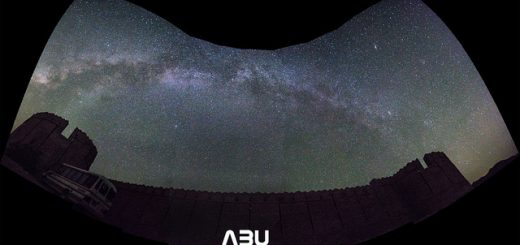Watching the Geminids Meteor Shower (Kalri Lake, Sind, Pakistan)
2 days before the peak of Geminids Meteor Shower back in December 2010, I was sitting on my seat while programming, I got an email. It was an email in which we planned to go to Kalri Lake, Sind for watching the Geminids meteor Shower. The peak of Geminids Shower is on 13 Dec. Unfortunately, the 13 was Monday and considering the work load at office I dropped the idea of joining the trip.
Lucky Day
I thought for a moment that this opportunity might not come every year, let’s do it. The KaAS team and Pak Wheels planned the trip route and all the required stuff. I was very excited to witness the Meteor Shower first time in my life. I got permission from my parents, packed my stuff especially warm clothes, and left on Sunday afternoon for Kalri Lake. . I had my Astronomy “Practical Skywatching book” with me and I tried to learn the techniques of observation in front seat while Mr. Khalid Marwat was driving and guiding me too. I had his book that described the techniques of observations.
Me reading Meteor Observing techniques by IMO (Photo by author)
Preparations
Mr. Khalid Marwat, me and Omair Zeeshan(a blogger from Express Tribune) left Karachi around 2pm and reached there before Asar. Then came Mr. Hanif Bhatti whom I met at my last dark sky trip at Hingol National Park. Mr. Khalid Marwat set up the telescope and explained the basics of telescopes to me and Omair Zeeshan. After a while I left for Magrib prayers and got a chance to capture the Sun set by lake. I was lucky to have my binoculars and my iPhone 2G with me.

Mr. Khalid Marwat (left) explaining the basics of telescopes and observation techniques to me and Omair Zeeshan (Photo by author)
Mr. Khalid Marwat and the Half-Moon
Mr. Hanif Bhatti, Fahad and Zain reached in Pajero (Shot by author)
Lake Photography Session and Dinner
Then we had a nice photography session at the lake restaurant while we waited for dinner. We had a great dinner.

Lake view from our observation place (Photo by Hanif Bhatti)

The constellation of taurus in view (Photo by Hanif Bhatti)
It is Time
It was time for some serious observation. We asked for the rest house authority to turn off all the lights so that we avoid the light pollution. Before we started observation, Mr. Khalid Marwat explained us the techniques of observation and how to log the counts of meteors. We were 3 keen observers including myself and so we were distributed in 3 so that each person had one area of the sky near the radiant.
Before I start the observation details let me explain the meteor shower and its terms
Let’s learn some basics
Meteor Shower:
“A meteor shower is a celestial event in which a number of meteors are observed to radiate, or originate, from one point in the night sky. These meteors are caused by streams of cosmic debris called meteoroids entering Earth’s atmosphere at extremely high speeds on parallel trajectories. Most meteors are smaller than a grain of sand, so almost all of them disintegrate and never hit the Earth’s surface.”
Radiant:
“The point in sky from where the meteors seem to appear.” Usually we always look on sides of the radiant and not the radiant. The radiant lies in some area of sky.
How are the showers named?
As we know each area in sky is divided into constellations (such as Orion, Gemini, Leo), the constellation in which the radiant lies is how meteors are named. The radiant of the meteor shower that peaks in December lies in the constellation of Gemini so it is named “Geminids Meteor Shower”.
How to watch/observe?
You don’t need a telescope or a binocular to watch the meteor shower. All you need is a dark sky and your naked eyes. Meteor shower comes under Naked eye Astronomy and this is how we did it.
How often Meteor Shower occurs?
Meteor Shower peaks every month. The meteor shower chart is shown below:
.jpg)
Moon Shooting (Waiting for Meteor Shower)
Meteor shower was to be started on Monday midnight, the 13th of Dec 2010. Usually meteor shower is better after midnight and best before Fajr time. We started to observe the half-moon through the telescope and took some shots with Khalid Sahab’s SLR and Fahad’s DSLR. The fun didn’t finish here. Mr. Khalid, put on the web cam on the telescope and then it was the LIVE view of the Moon in his laptop screen. I assist him to focus and then I took some shots with it.

Moon through 8inch Meade telescope (Photo by Fahadullah)

Photo through the webcam, high magnification to view the Craters (Photo by author)
With the Starry Night
After Moon watching, we had a shot in the dark night under the starry sky of Kalri Lake.
From Midnight till Dawn – How many meteors?
We settled ourselves as directed and started observing the shower. Every now and then I say “Wow, look there” and I used to get a reply from Zain “Look there”. The meteor shower was excellent. Every now and then, we saw a meteor passed by and sometimes we could see from the corner of the eye. There wasn’t an interval of more than 5 minutes when we hadn’t seen a shooting star (meteor). The meteor shower rate was great at night of 13th Dec 2010.
We were lying on the ground besides the lake. Zain was in his sleeping bag, and so was Mr. Khalid. I didn’t have sleeping bag and just had a thin jacket. It was winter time and we were beside the lake. One can imagine what happened to us. At around 3am I could see water droplets all around my jacket and on the telescope and cars. It was quite cold by that time and since we were lying I got sleepy. In morning, we counted roughly using our observation reels, and found out that together we had watched around 150 meteors overnight.
Meteor Shower Photography
Me, Mr. Khalid Marwat and Zain kept counting the meteors in our respective areas and outside these areas as well. Meanwhile, Hanif Bhatti, was taking some wonderful night shots and was trying to capture meteors. Mr. Khalid Marwat fixed his camera on the telescope to get some night shots too. After a few hours, Mr. Hanif Bhatti and Mr. Khalid Marwat, both got some amazing photos of the night sky and the meteors. J

A meteor (shooting star) can be seen on the second tree top from right side (Photo by Mr. Khalid Marwat)
It was too cold and so I had to go inside the Car. I could see the lake, the ground, and the beautiful night sky from the Car window. After a while, I woke up and it was Fajr time. I could see everyone was awake and preparing to pack.
Time to Pack
We packed while talking about the night enjoying the lovely breeze. Mr. Khalid Marwat explained us how we can make our readings useful and how actually we can interpret them to submit it to the IMO. After a few days, we submit the results to IMO and they were published on the IMO website here.
Journey back to Karachi
It was Monday, I had slept only 1 hour and worse what it was work day. I had to reach at office at 9am. We left the lake after Fajr when our star “The Sun” has risen. I was in Hanif Bhatti’s Pajero with my readings. It was 10am and we were still on our way back. What happened after I reached home is another long story.
Meteor Shower recording reels while going back to Karachi (Photo by author)
It was an amazing experience not just of the Meteor Shower but of the starry night, the moon shooting and the lake experience and photography experience was awesome!










